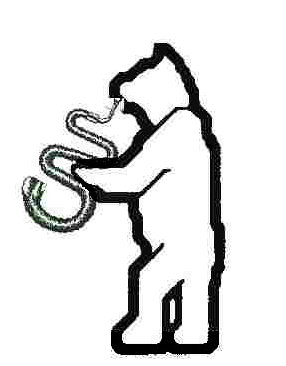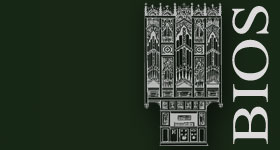 |
Barrel organs - 1 |
|
|
Barrel organs
Christopher Turner
Article reproduced from the BIOS REPORTER, April 1997, Volume XXI, No.2
(Christopher was an active member of the WGMA until his
untimely death)
In Thomas Hardy's novel, Under the Greenwood Tree (1873), William Dewy, violoncellist and bass to the church band, was moved to say: 'And harmonions,' William continued in a louder voice, and getting excited by these signs of approval, 'harmonions and barrel-organs' ("Ah!' and groans from Spinks) 'be miserable -what shall I call' em?- miserable -....Miserable dumbledores!' Hardy portrays sympathetically the feelings of players facing the demise of the choirs and instrumental bands which had accompanied the metrical psalms in many of our churches and dissenting chapels since the Restoration until the mid-nineteenth century. Notwithstanding, the organ was considered to be the most desirable instrument for use in worship during this period - a view supported by Thomas Mace in his book Musick's Monument (1676) suggesting that the Parish 'Clark' should be taught to play the common psalm tunes at minimal cost to the parish and that, when that dignitary was
However, many parishes, especially those in rural areas, failed to proved an organ due in all probability to the initial cost of purchase, the cost of upkeep and repair, the uncertainty of obtaining the services of an organist, the need to provide some kind of remuneration, and the limited use to which an organ could be put. So it was that small bands of instrumentalists prevailed, giving rise to many colourful anecdotes such as this one from Heanton Punchardon Church, Devon:
However there was an alternative form of support at hand. The Barrel Organ. Although the barrel mechanism as applied to the organ was known long before the Restoration, the earliest claim (unsubstantiated) for the installation of such an instrument is at the church of King Charles the Martyr, Peak Forest, Derbyshire, c.1700. (Williams. P. & Owen.B. The Organ (1988) p.229). The manufacture of church barrel organs was at its peak from about 1760 to 1840 which co-incides with the main period of band activity. In many churches the barrel organ caused the demise of the band as the Hardy quotation suggests, and there is evidence to show that this was often the case, as at Masham, Yorkshire, where the band:
A relative of the Rev. Sabine Baring-Gould recorded in her 1813 diary that she:
Not everyone agreed. In his Essays, Historical and Critical, on English Church Music(1795) the poet William Mason professed his preference for the 'mechanical assistance of the Cylindrical or Barrel Organ to the fingers of the best parochial organists' , a view which probably reflected his preference for music free from elaborate decoration so prevalent in the eighteenth century. This apart, the use of mechanical musical accompaniment offered other considerable advantages. Barrel organs were cheaper than a conventional organ having fewer pipes which, although limiting the keys available, made them compact. They could be operated by a person of no technical ability and were musically reliable, factors which the organ builders Bryceson were not slow to point out in material they published c.1815 where they claimed that barrel organs were 'equal in performance to a finger organ, and will entirely supersede the use of other instruments'. The problem with the barrel organ was its limited repertoire. Few instruments had more than three barrels of ten tunes each, and when in 1874 the rector of Bulwick Church, Northamptonshire, complained of their barrel organ that 'it has 30 tunes of which we are all tired', his brother George Maydwell Holdich designed and built a new two-manual and pedal organ for his parish. The limitations of the barrel organ were far less apparent if it were used to supplement the musical accompaniment, and there is evidence it co-existed with a gallery band in many parishes. At St Andrew's Church, Fingringhoe, Essex, a choir and band were active in 1801 when a local farmer, Joseph Page, recorded in his diary on 21 June that:
The band survived until 1860 when a harmonium ws introduced, but a barrel organ was installed during this period, and the churchwardens' account record payment to an 'organist'. Similarly at Parson Woodforde's Church, Castle Cary, Somerset, in 1768 the barrel organ was removed by a group of men from the gallery into the body of the church for use when the gallery musicians were not in attendance. (K. Baddeley, Trouble in the Gallery, the Gallery Tradition, Aspects of Georgian Psalmody, ed. C. Turner,1997) In order to make the barrel organs more interesting, some were built with a conventional keyboard. A further interesting development was the provision of a 'dumb organist'. An independent barrel mechanism was positioned over the keyboard, keys being depressed by means of wooden fingers (trackers). During this period, barrel organs were gradually replaced by harmoniums and 'finger-organs' especially in the wake of the Great Exhibition 1851. From then on we find advertisements offering barrel organs at lower and lower prices - by the end of the century we find
Inevitably, some churches retained their barrel organs long after that had ceased to be in general use; the church of King Charles the Martyr, Shelland, Norfolk, has an unbroken tradition since the instrument was purchased c. 1815. Apart from their historical value, barrel organs can shed
light on performance practices relevant to their time: Some pinned tunes contain ornamentation reflecting contemporary practice. Little has been transcribed. Some barrels have been pinned with interludes between verses of a hymn or psalm, reflecting eighteenth century practice found in printed editions. The speed with which a barrel is turned depends on the speed with which the handle is turned and is therefore variable. However, where the speed of the barrel and the air supply are linked (same person!) a minimum speed must be maintained while too fast a speed will tell on the grinder. Registered charity no. 283936 |
